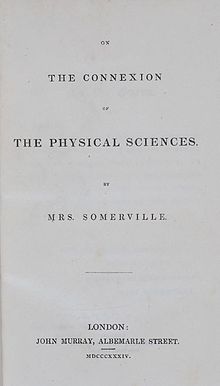On the Connexion of the Physical Sciences
Appearance
This article needs more links to other articles to help integrate it into the encyclopedia. (July 2016) |

On the Connexion of the Physical Sciences is one of the biggest selling science books in the 19th century. It was written by Mary Somerville in 1834.
The book went through many editions and was translated into several European languages.[1][2][3][4] In a review of the book in March 1834, William Whewell coined the word "scientist".[5][6]
References
- ^ "Nature Podcast". 30 October 2014. Retrieved 5 November 2014.
- ^ Holmes, Richard (2014). "In retrospect: On the Connexion of the Physical Sciences". Nature. 514 (7523): 432–433. doi:10.1038/514432a. ISSN 0028-0836.
- ^ Secord, James (2014-03-18). Visions of Science: Books and readers at the dawn of the Victorian age. OUP Oxford. pp. 107–134. ISBN 9780191662751. Retrieved 5 November 2014.
- ^ Patterson, E. C.; Eisberg, J (June 1985). "Book Review: "The Queen of Nineteenth-Century Science": Mary Somerville and the Cultivation of Science, 1815–1840". Journal for the History of Astronomy. 16 (2): 144–146. Bibcode:1985JHA....16..144P. doi:10.1177/002182868501600209.
- ^ Ross, Sydney (1962-06-01). "Scientist: The story of a word". Annals of Science. 18 (2): 65–85. doi:10.1080/00033796200202722. ISSN 0003-3790.
- ^ Warner, Deborah Jean (1990-03-01). "What is a scientific instrument, when did it become one, and why?". The British Journal for the History of Science. 23 (01): 86. doi:10.1017/S0007087400044460. ISSN 1474-001X.
External links
